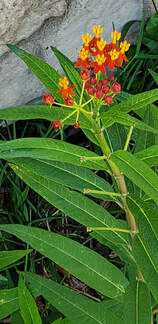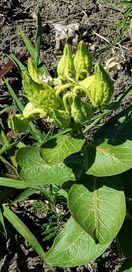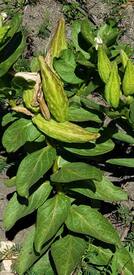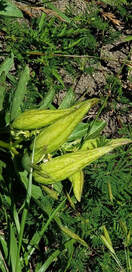|
In the summer of 2020, with permission from the landowner, I checked out some unusual looking ‘weeds’ growing in the vacant lot across the street from my house. I encountered a plant with odd looking pods, one which I had never seen before. I took pictures then checked my plant app and plant id group on social media and learned it was Milkweed. Next, I started researching information about it. I was surprised to discover that Milkweed is also called Butterfly Weed. How ironic – a plant I had purchased and planted in my garden (without realizing its importance at the time) was also one I had been trying to find under a different name - Pleurisy Root. As you'll see in the pictures below, the wild Milkweed I found is a different species from the one I'm purposely growing. (And I left it alone except to take pictures!)  Left: Butterfly Weed (A. tuberosa) in my garden, late summer 2020. The leaves are narrower and the plant is taller than the A. viridis pictured above. Also known as Milkweed, the leaves of Asclepias are the only food that meet the nutritional needs of Monarch caterpillars. It's a favorite for Monarch Butterflies as well, though the butterflies can get their nectar from other sources. This blog will focus on only one of the more than 100 species of Asclepias - A. tuberosa. So it's food for Monarchs, honey bees, humming birds, etc. Is it good for humans? Why is it important for people to forage responsibly with Milkweed? Are there any cautions with A. tuberosa?
To answer these questions, I'll have you look at one of the common names for A. tuberosa - Pleurisy Root. Pleurisy is swelling of the lining of the lungs usually due to lung infection (like bronchitis or pneumonia) or injury. If you guessed that Pleurisy Root can help with the lungs, you're correct, but it can also help with other issues. Pleurisy Root has been used by many Native American tribes for thousands of years. The roots are a well-known remedy for lung ailments from bronchitis to pneumonia, and its cooling, drying, and relaxing energetics are perfect for any type of hot, wet, stuck congestion. Infusion, tincture, or tisane made from the roots may reduce pain and inflammation, open the capillaries of the lungs, thin the mucus, dilate the bronchial tubes, relax spasms, and loosen and help expel phlegm. As a diaphoretic and diuretic, A. tuberosa will also help the body cool down, move stuck lymph, and detoxify from fever and illness by promoting perspiration and urination. In a lotion, salve, or wash Butterfly Weed can be used to calm a variety of skin conditions and wounds while bringing relief to injuries or joint and muscle pain. This is because of its analgesic, anti-inflammatory, and antispasmodic properties. To achieve this end, you might infuse the root in a carrier oil (like coconut oil), then add the infused oil to a lotion or salve. In the digestive and excretory systems, Pleurisy Root may act to calm hot indigestion and gas while relieving constipation. Yet, it is also used to alleviate dysentery and chronic diarrhea. There are some warnings that come with this herb. First, you need to know which species you have. Second, do not use Pleurisy Root if you are pregnant or breastfeeding. Third, all parts of the plant must be cooked before consuming because the raw plant contains cardiac glycosides which may affect the heart. Lastly, the older, more mature plants could be toxic. As a final note about Asclepias tuberosa, I highly recommend growing several plants in your garden. By doing so, you'll attract and provide food for the Monarchs, other butterflies, bees, and hummingbirds. It would also give you a handy source of Pleurisy Root without the need to forage in the wild which could deplete Monarch food sources. Remember, the Monarch butterfly lays one egg on each Milkweed plant. When that egg hatches, the caterpillar will eat leaves from that plant until it pupates. These leaves are the ONLY food that will provide enough nutrition for the Monarch to reach it's appropriate size. For more detailed information about this beautiful and beneficial plant, become a member and check out the Datasheet.
0 Comments
Leave a Reply. |
DisclaimerThe information contained in this blog is for educational purposes only and has not been evaluated by the Food and Drug Administration. Archives
March 2021
Categories |



 RSS Feed
RSS Feed